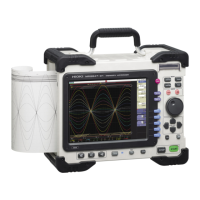8.5 Converting Input Values (Scaling Function)
128
About the Scaling
Function
Use the scaling function to convert the measured voltage units output from a sensor
to the physical units of the parameter being measurement.
Hereafter, "scaling" refers to the process of numerical value conversion using
the Scaling function.
Gauge scales, scale values (upper and lower limits of the vertical axis (voltage
axis)) and A/B cursor measurement values can be displayed in scaled units.
Scaling is available for each channel.
Scaling Setting Example
See: When using a clamp sensor ( p.130) (Example: Converting [ V ] →[ A ])
When using the Strain Unit (
p.131) (Example: Converting [ με ] → [ G ])
Scaling Methods Two scaling methods are available:
• Conversion Ratio Setting
• Two-Point Setting
8.5 Converting Input Values (Scaling Function)
Before Scaling After Scaling
Set the physical value per volt (conversion ratio:
eu/V) of the input signal, an offset value and mea-
surement unit name (eu: engineering units) for
conversion, so measurement values acquired as
voltage are converted to the specified units.
Example:
Conversion ratio: A value per volt, Offset value:
B, Unit name: A
Conversion Ratio Setting
[A]
[V]
Convert from slope (conversion ra-
tio) and offset value
B
(:Example: Converting [V] → [A])
Set the voltage values of two points of the input
signal, the converted unit value of these two
points and the name of the converted measure-
ment units, so measurement values acquired as
voltage are converted to the specified units.
Example:
Unit name: A
Voltage value at
2 points
Voltage of units to
convert
V
H
: Higher poten-
tial point
A
H
: Value for higher
potential point
V
L
: Lower poten-
tial point
A
L
: Value for lower
potential point
Two-Point Setting
A
H
A
L
V
L
V
H
[A]
[V]
Conversion ratio and offset value are
calculated from the two points and
converted
Actual measurement values
Converted unit values

